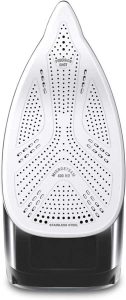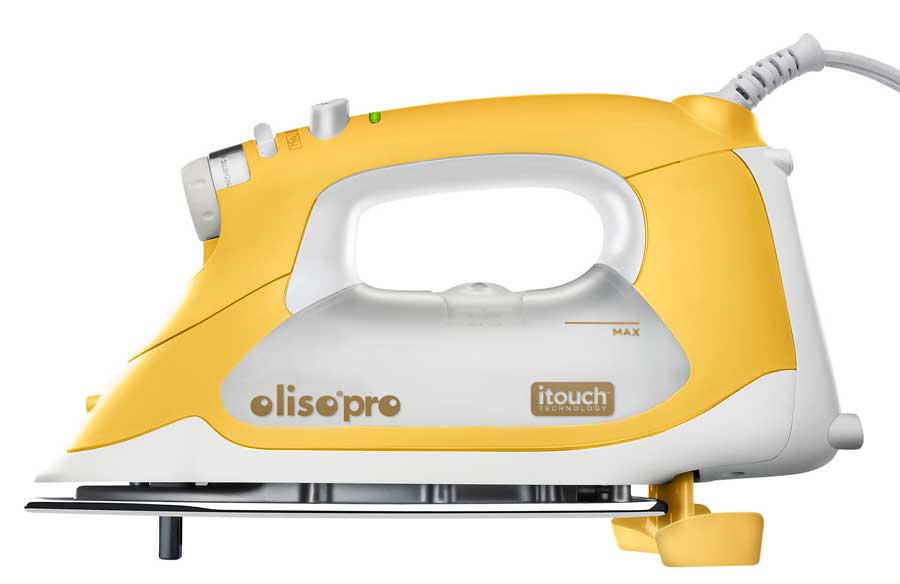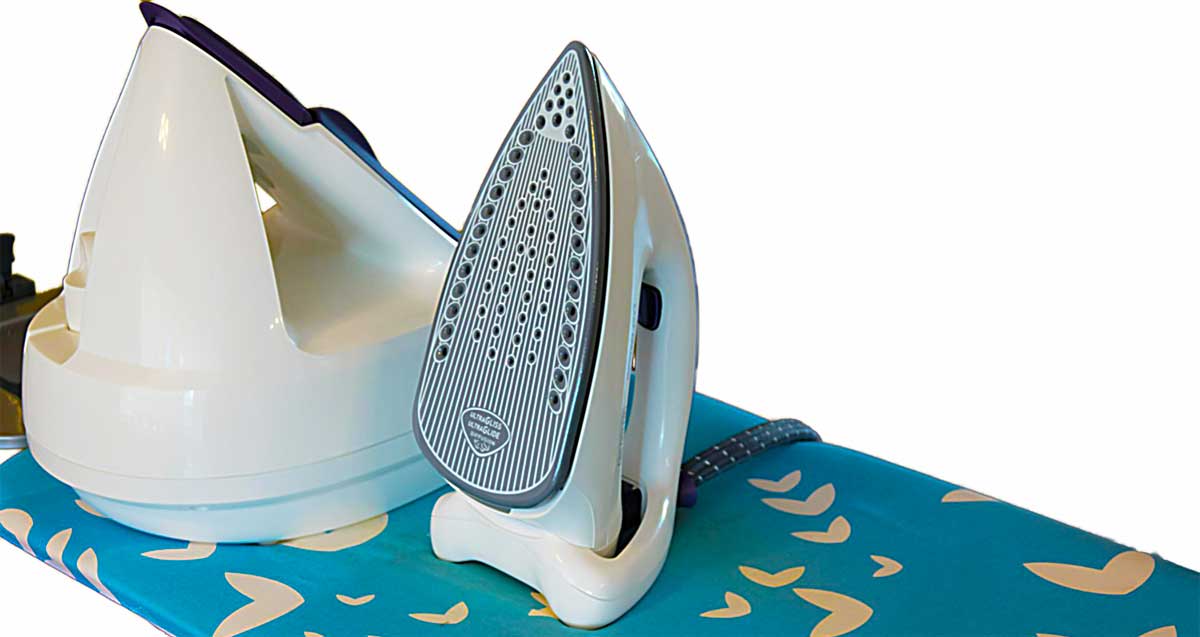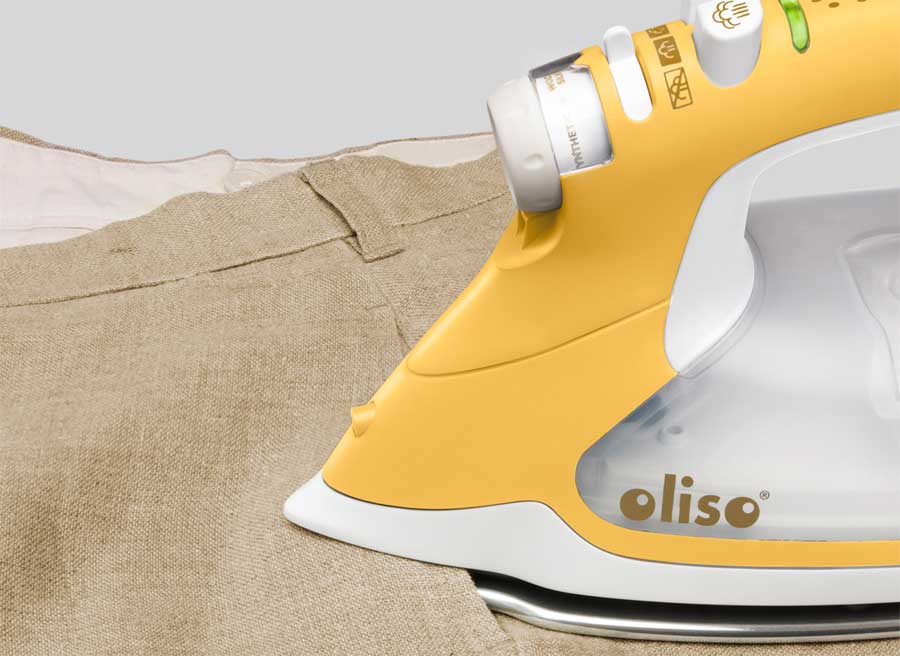Next to your sewing machine, your iron may be the most important item in your sewing room. Look for features that fit your sewing needs.
Auto shut-off
Some sewers love it, others loathe it—that “feature” that turns your iron off when it’s not used for a certain period of time. Shut-off times vary up to 15 minutes of non-use. Although designed as a safety feature, there are many irons without this option if you find it an annoyance.
Warming Ways
Some irons have dials, others have digital read-outs to tell you actual ironing temps, but still others list only fabric/fiber names, like cotton, silk or wool to indicate a safe temperature setting. A few brands offer only dots or arrowheads to indicate temperature ranges. Choose a brand with an indicator that works best for what you want to know.
Bottoms Up

You may never have given it a thought, but if you research irons, you’ll find aluminum, stainless and ceramic soleplates available. Some also offer a non-stick coating—ideal if you do a lot of fusing.
Depending on the type of sewing you do, the number of steam holes in the soleplate may be important. You can get more than 400, like in the Rowenta DW8270 Pro Master 1750 Watt X-CEL Steam Iron with 400 Hole HD Profile Soleplate pictured to the right, all the way down to less than 50, depending on the brand and model. If you do a lot of tailoring, look for a higher number of steam holes with many near the iron’s point.
The soleplate shape is also a consideration as some irons are very pointed with a space for detail pressing, while others are more rounded for more general use.
Hefty, Hefty, Hefty
Most home irons fall in the 1- to 5-pound range for weight. For tailoring, heavier is better as more pressure is applied to shape the fabric during construction.
Steamy Situations
 Sewists (and most quilters) love steam, and it comes in various forms. Some irons offer only a single steam setting, others offer adjustable steam–from bursts to continuous—depending on your needs. Irons should also offer a dry setting for those fabrics that can be damaged by water or for use with some fusible products. Some irons steam only in a horizontal position, while others can also steam in a vertical position.
Sewists (and most quilters) love steam, and it comes in various forms. Some irons offer only a single steam setting, others offer adjustable steam–from bursts to continuous—depending on your needs. Irons should also offer a dry setting for those fabrics that can be damaged by water or for use with some fusible products. Some irons steam only in a horizontal position, while others can also steam in a vertical position.
If you like convenience, look for a removable water tank to take directly to the faucet for filling. A transparent tank lets you keep tabs on the amount of water in the iron and know when a refill is needed. Check the size of the water tank, as smaller capacity reservoirs require more frequent filling, especially if you’re using a lot of steam.
In addition to steam, some irons offer a misting or spray feature to allow for a bit of extra moisture in certain pressing situations—especially helpful for shaping fabrics and removing wrinkles.
Fill ‘er Up!
Note what type of water the iron requires. Many simply take tap water, but others require distilled water. There may be regional differences, depending on the water where you live. Using hard water can lead to a build-up of residue in the tank (or on your sewing project) and clogged steam vents, so check for a self-cleaning feature.
It’s a good idea to empty the water in your iron if you’re not going to be using it for a while to help prevent mineral build-up in the tank.
Plugging In
Think about where you’ll be ironing and check the cord length—they can be up to 12 feet long. Some irons offer a retractable cord for easier storage. Iron cord positions can be fixed or they can pivot for convenience of both left- and right-handed users. Cordless models are also available with a charging base, but keep in mind that the head has to be returned to the base frequently to reheat itself.
Sit-ups
Most irons sit vertically on their heel when not in use, but one brand {Oliso photo) has “legs” that raise it off the ironing surface when not in use, so there’s no need to set it upright. When you hold the handle, it lowers itself for use.
Liking it Hot
It’s important to let any iron fully heat up before using it. If you don’t, it may spit water onto your project. Some irons fully heat in 30 seconds, other take as long as 10 minutes. There may be a beeper or a light to indicate when the desired temperature is reached.
~Linda Griepentrog
Linda is the owner of G Wiz Creative Services and she does writing, editing and designing for companies in the sewing, crafting and quilting industries. In addition, she escorts fabric shopping tours to Hong Kong. She lives at the Oregon Coast with her husband Keith, and two dogs, Yohnuh and Abby. Contact her at gwizdesigns@aol.com.







